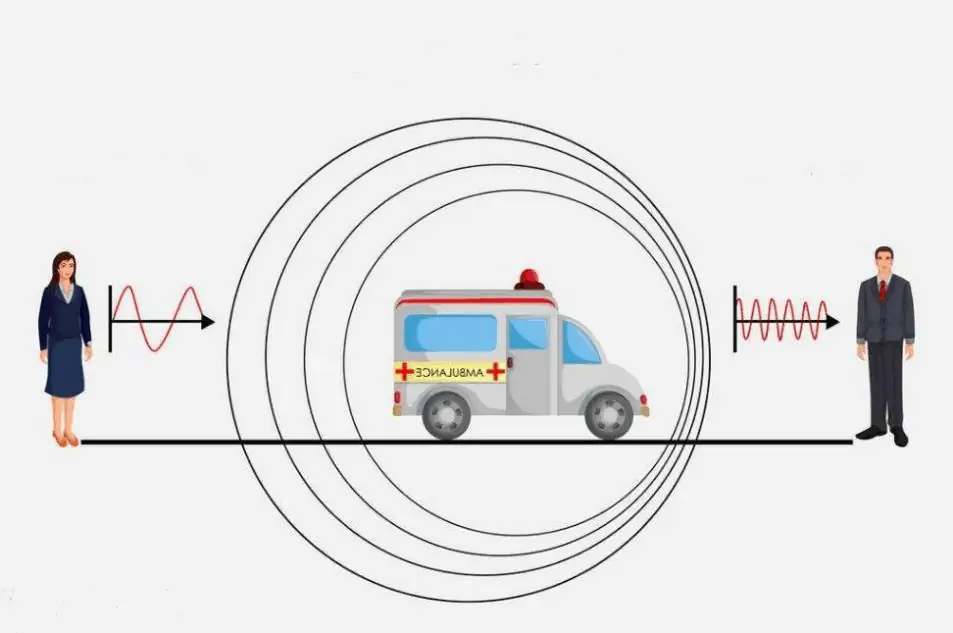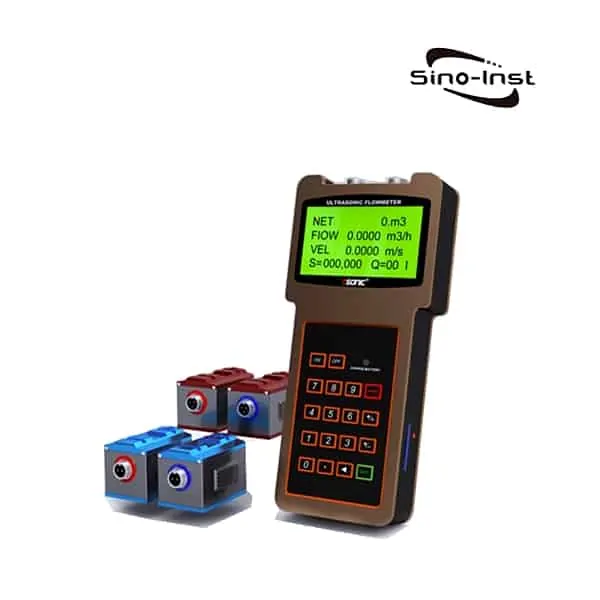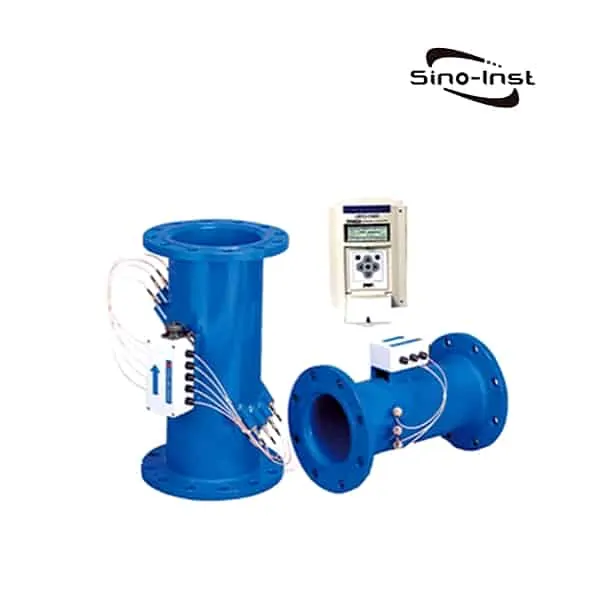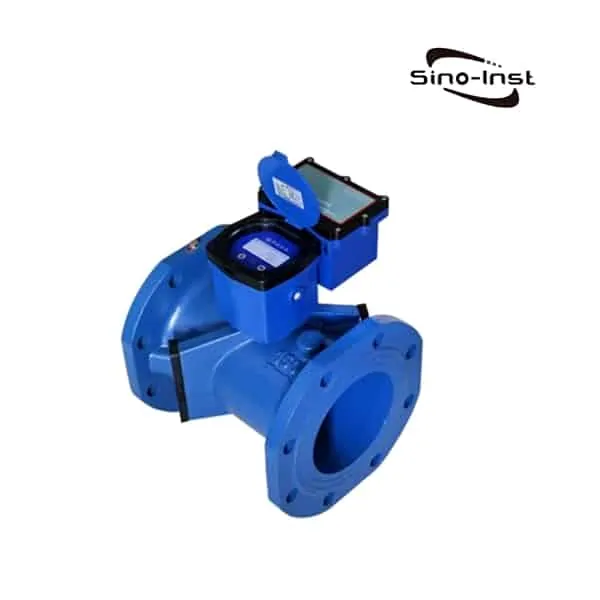What is a Doppler flow meter? Doppler Flow Meter is a flow meter that uses the doppler effect principle to monitor the liquid flow rate.

Doppler Flow meter use reflected ultrasonic sound to measure the fluid velocity. By measuring the Doppler frequency shift of the sound waves scattered by the moving particles in the fluid, the velocity of the fluid can be obtained. Combined with the built-in pressure water level gauge. Using the velocity area method. The flow of liquid can be measured. Suitable for flow measurement in open channels, rivers, and various full and partial open channels.
Sino-Inst offers a variety of Ultrasonic flow meters for flow measurement. If you have any questions, please contact our sales engineers.
Features of Doppler Flow Meter
- All functions in one design. Simultaneous measurement of average flow rate, water depth, and water temperature
- The velocity area method is used to measure the flow, and there is no head loss. There is no need to build a standard weir.
- The ultrasonic Doppler principle is used to measure the flow velocity. The measurement accuracy is high and the initial speed is low.
- No mechanical rotor structure. It has no effect on the water flow state, and the measurement is more accurate.
- Comes with a temperature sensor. It can be used to compensate for the effect of water temperature on the speed of sound.
- It can measure instantaneous flow and cumulative flow.
- Using frequency domain Doppler analysis algorithm. The data is stable and reliable, and the real-time performance is strong.
- Simple installation. No need for auxiliary engineering facilities
Specifications of Doppler Flow Meter
| Fluid velocity | Range | 20mm/s-5000mm/s |
| measurement accuracy | ±1% of measured flow rate | |
| Resolution | 1mm/s | |
| Liquid level | Range | 0-5m |
| measurement accuracy | ±1cm | |
| Resolution | 1mm | |
| Flow rate | Range | 0.001m3/s to 9999m3/s depends on the actual section |
| measurement accuracy | ±3% | |
| Resolution | 0.0001m3/s | |
| Other parameters | Power supply range | 9-24V |
| Collection cycle | Can be set | |
| Interface Type | RS485(Modbus) | |
| Storage temperature | -20-80℃ | |
| Operating temperature | 0-60℃ | |
| Protection level | IP68 | |
| shell material | PVC |
Guess You’ll Like: Ultrasonic flow meters types & technical guide
What is a Doppler flow meter?
Doppler flowmeter is an ultrasonic flowmeter that uses the Doppler effect of sound waves propagating in fluids. It is suitable for the flow measurement of open channels, rivers and difficult-to-build standard sections, as well as the flow measurement of various full and partial open channels.
The Doppler flowmeter uses the principle of ultrasonic Doppler to measure. By measuring the Doppler frequency shift of the sound waves scattered by the moving particles in the fluid, the velocity of the fluid can be obtained. Combined with the built-in pressure water level gauge, the velocity area method can be used to measure the flow rate of the liquid.
According to different application scenarios, it can be called river flowmeter, sewer flowmeter, channel flowmeter, farmland irrigation flowmeter, non-full pipe flowmeter, etc.
Doppler flowmeters do not need to cut off the pipeline to install pipe-segment sensors like electromagnetic flowmeters. There is no need to use a shut-off device. Do not install a fixed weir to control the flow of water from a fixed outlet.
The Doppler flowmeter can measure in both clean and muddy water, and can also measure reverse flow velocity.
Read mroe about: Irrigation Flow Meters for Agriculture Water System
Doppler flow meter working principle
For flow velocity measurement, the first thing to explain is the Doppler shift. When there is relative motion between the wave source and the observer, the frequency received by the observer is different from the true frequency of the wave source. The difference between the frequency of the received signal and the frequency of the sound source is called the Doppler shift. Its size is determined by the relative speed between the two. This physical phenomenon is called the Doppler effect.

When measuring the flow velocity, the wave emitted by the probe encounters suspended matter, solid particles, vapor bubbles, and even unstable vortices and disturbances in the medium that follow the wave. Both will produce reflected waves that deviate from the transmit frequency, resulting in Doppler frequency changes. This effect is proportional to the velocity of movement of the reflector.
The receiving probe receives the reflected wave from each point. After complex signal processing, dynamic spectrum analysis and accuracy calculation. The flow velocity of the fluid in the pipe section can be obtained.
Flow rate calculation
The ultrasonic beam emitted from the Doppler velocity sensor (transducer) encounters particles or bubbles moving in the fluid. It is reflected back and received by the Doppler flow sensor (transducer). The Doppler frequency shift of the transmitted signal and the received signal is proportional to the fluid velocity.

Among them:
u is the channel flow rate,
f1 is the working frequency of the sensor,
δfd is the Doppler frequency difference.
Flow calculation
Real-time flow velocity and water level data collected by acoustic Doppler flowmeter.
The data acquisition and processing unit receives the flow rate and water level data. Calculate the instantaneous flow rate and record it as Qs;
Then calculate the accumulated flow rate and record it as Q; its flow rate can be calculated as follows:
Qs=AV
In the formula, A is the water area of the pipeline, and V is the average flow velocity of the section.
Q = QsT
In the formula, the instantaneous flow of Qs section, T is the accumulated time (unit h).
Read more about: Ultrasonic flow meters types & technical guide
Portable Doppler Flow Meter
The Portable Doppler Flow Meter uses the Doppler effect of sound waves propagating in the fluid. Hand-held design, suitable for handheld wading water flow measurement.
The Portable Doppler Flow Meter (Model: LSX-2) can obtain the velocity of the fluid by measuring the Doppler frequency shift of the sound waves scattered by the moving particles in the fluid. Combined with the built-in pressure water level gauge, the velocity area method can be used to measure the flow of the liquid. It is suitable for flow measurement of open channels, rivers, pipelines and difficult-to-build standard sections. It can work continuously for more than 12 hours on a single charge.
Transit time vs Doppler flow meter
There are two types of ultrasonic flowmeters, one is the time difference measurement method, and the other is the Doppler method. Many users often only know one of them.
Here, we make a simple comparison so that you can choose the correct model.
1.The measurement principle is different.
The main principle of the time difference method is that when the ultrasonic beam propagates in the liquid, the flow of the liquid will cause a small change in the propagation time. The change in its propagation time is proportional to the flow rate of the liquid.
At zero flow, the time required for the two sensors to transmit and receive sound waves is exactly the same. The only technology that can actually measure zero flow.
When the liquid is flowing, the transmission time of sound waves in the counter-current direction is longer than that in the downstream direction. The Doppler method uses the characteristic that the ultrasonic wave will be scattered when encountering tiny solid particles or bubbles in the propagation path.
2.The applicable medium is different.
The time difference ultrasonic flowmeter can only measure clean liquids. It will not work well when it contains more solid particles or bubbles.
The Doppler method uses the scattering characteristics of ultrasonic waves for measurement. Therefore, the Doppler method is suitable for measuring fluids containing solid particles or bubbles, but clean liquids cannot be measured.
3.The measurement accuracy is different.
The time difference method has higher measurement accuracy, and the Doppler method has lower measurement accuracy.
Since scattered particles or bubbles exist randomly, the sound transmission performance of the fluid is also different. If it is a fluid with poor sound transmission performance, the scattering is stronger in the low velocity area near the pipe wall.
However, the scattering of fluids with good sound transmission performance is dominant in the high velocity area, which makes the measurement accuracy of the Doppler method lower.
Although it adopts a structure in which the transmitting transducer and the receiving transducer are separated. In this way, only the scattering in the middle area of the velocity profile can be received. However, the measurement accuracy is still lower compared with the time difference method.
4.The working conditions are different.
The time difference method is suitable for full pipe measurement.
The Doppler method is suitable for measuring the flow of full pipes, partial pipes, open channels, etc.
OMEGA Engineering has a good explanation of Doppler vs Transit Time. Let’s look together.
Video source: https://www.youtube.com/watch?v=NQWNYARWmB8
More Featured Ultrasonic Flowmeters
Sino-Inst, Manufacuturer for Ultrasonic Doppler Flow Meters. It can measure a single sound-conducting liquid medium. It can measure even liquids such as water, sea water, oil, and slurry.
Sino-Inst’s Ultrasonic Doppler Flow Meter, made in China, Having good Quality, With better price. Our flow measurement instruments are widely used in China, India, Pakistan, US, and other countries.

Wu Peng, born in 1980, is a highly respected and accomplished male engineer with extensive experience in the field of automation. With over 20 years of industry experience, Wu has made significant contributions to both academia and engineering projects.
Throughout his career, Wu Peng has participated in numerous national and international engineering projects. Some of his most notable projects include the development of an intelligent control system for oil refineries, the design of a cutting-edge distributed control system for petrochemical plants, and the optimization of control algorithms for natural gas pipelines.












